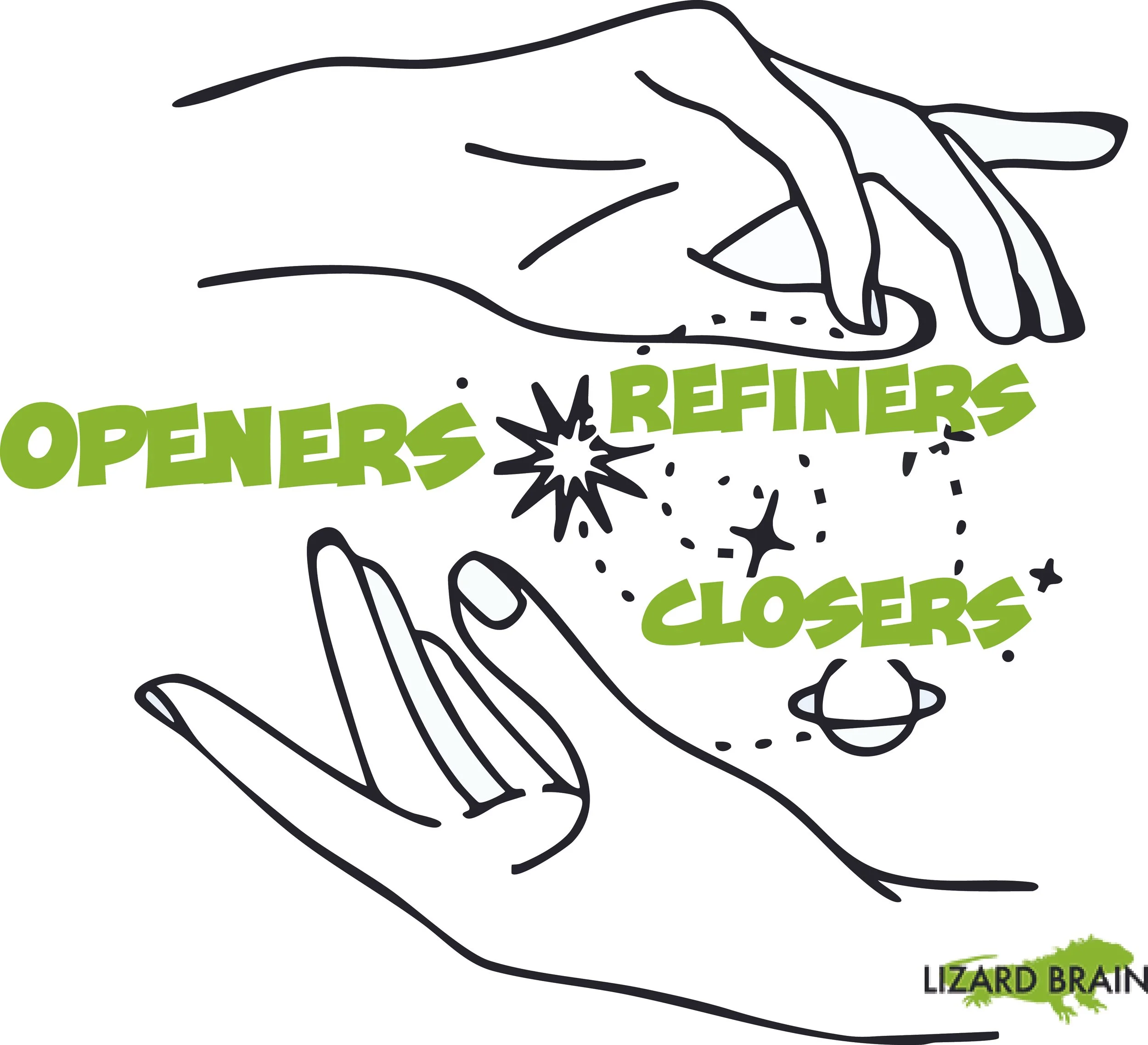Decision-Making Magic with Openers, Refiners, and Closers
Facilitating a group decision-making process can feel like guiding a ship through uncharted waters. You have a room full of great minds who bring their own ideas, insights, and biases to the table. Your job as a facilitator? To steer the conversation in a way that ensures everyone can contribute, collaborate, and walk away with a shared sense of direction.
That’s where participatory decision-making comes in. Breaking the process into three modalities – Openers, Refiners, and Closers – can help you facilitate more dynamic, inclusive, and effective sessions. Let’s take a look at these modalities and the tools you can use to make them work for your group.
Openers: Bring New Ideas to the Table
Openers are all about possibilities! This is when you encourage the group to generate new ideas, explore their creativity, and throw everything on the table. Borrowing from Alex Osborn, the inventor of brainstorming:
The more wild the idea, the better,
The more ideas, the better,
Build on the ideas of others, and
Withhold judgment
Open the floodgates and build momentum!
Techniques for Openers
Here are some tools to get those creative juices flowing:
Brainstorming: A classic go-to method. The key is creating a judgment-free zone where everyone feels comfortable sharing. Use visual elements like sticky notes or a digital collaboration tool like MURAL to capture each idea.
Mindmapping: Start with a central theme or question, then branch out into related ideas. Mindmaps are fantastic for visual thinkers, as they literally connect thoughts and concepts.
1-2-4-All: Ask the group to reflect individually on a question for a moment, then pair up to share their thoughts. Pairs combine into fours, and then everyone shares with the larger group. This helps people feel heard throughout the entire process.
Think/Write/Share: Give participants 60 seconds of quiet time to think, 60 seconds to jot down their ideas, and 60 seconds to share. This method works well for anyone who performs better with a moment to gather their thoughts.
Getting the most out of Openers means staying flexible. Encourage wild ideas and remind participants there are no “wrong” suggestions at this stage.
Refiners: Find Diamonds in the Rough
Once you’ve gathered all the ideas, it’s time to sift through them to uncover the most promising ones. This refining phase is about evaluating, narrowing down options, and weighing potential. This is where many minds working together bring vague ideas into sharp focus.
Techniques for Refiners
Here are a few ways to help your group refine effectively:
Voting Methods:
Show of Hands: Quick, simple, and good for low-stakes decisions.
Straw Poll: Participants vote to gauge interest, even if it’s non-binding.
Gladiator Poll: Participants place their "votes" as symbols next to ideas (thumbs-up, thumbs-down, or neutral).
Fist of Five: Each person rates an idea from one (hate it) to five (love it) with their fingers. It’s visual and quick.
Gradients of Agreement: A more nuanced version, where participants express their level of support ranging from “wholehearted agreement” to “serious concern.”
2x2 Comparison:
Draw a quadrant with two axes that represent different criteria. For example, you could compare ideas based on “ease of implementation” on one axis and “impact” on the other. This visual exercise simplifies the decision-making process by organizing concepts spatially.Decision Model Flowchart:
Create a flowchart with specific criteria as gates. For instance, if you’re choosing a project idea, your chart might first filter for budget feasibility, then staff capacity, and so on. This visual roadmap helps a group clearly see why certain ideas make the cut.
During this phase, remind participants that not every idea will move forward. Encourage them to focus on collective success rather than individual preferences to keep the team spirit strong.
Closers: Agreeing on Commitments and Planning the Way Ahead
After Openers and Refiners comes the finish line. Closers are about turning decisions into action plans. This is when you lock in outcomes and guide your group toward clarity on next steps. It’s the difference between a session that ends in “great talk!” and one that ends with “here’s what we’re doing next.”
Techniques for Closers
Bring it all together with these tools to map out the path forward:
Action List: Break the decision into actionable tasks. Clearly define who is doing what, and by when. Be specific! For example, “Tracy will create a draft proposal by next Thursday.”
Calendar: Visualize deadlines by plotting them on a calendar. You can use a physical calendar, digital tools, or even an oversized wall chart to make sure the plan stays visible and on track.
Project Plan: For bigger decisions, outline the key steps, milestones, roles, and resources needed for success. A simple Gantt chart can do wonders here.
Closers are also a great time to check in with the group. Ask, “Does everyone feel clear about what happens next?” This creates alignment and ensures no one walks away with lingering doubts.
Tips for Using Modalities Seamlessly
Mix It Up: You can do Openers, Refiners, and Closers in any order! For example, you might start with a straw poll BEFORE brainstorming just to make sure a topic is worth exploring. You might do TWO refiners just to double-check the outcome of the decision making process.
Tailor to Your Group: Think about what dynamic best suits the participants. Do they work better with visuals? Hands-on tools? Structured conversation? Customize your methods accordingly.
Engage with Visuals: Use charts, sticky notes, drawings, or templates to help participants see their ideas and decisions. Visuals support memory and clarity.
Bringing It All Together
Participatory decision-making thrives on balance. Openers bring the energy, Refiners add focus, and Closers deliver the clarity. When you guide a group through all three, you empower them to collaborate and move forward with confidence.
The next time you’re facilitating, pay attention to how these modalities shape the conversation. With the right mix of methods (and a touch of your facilitator flair), you’ll help your group turn creative chaos into a crystal-clear plan. Happy facilitating!

